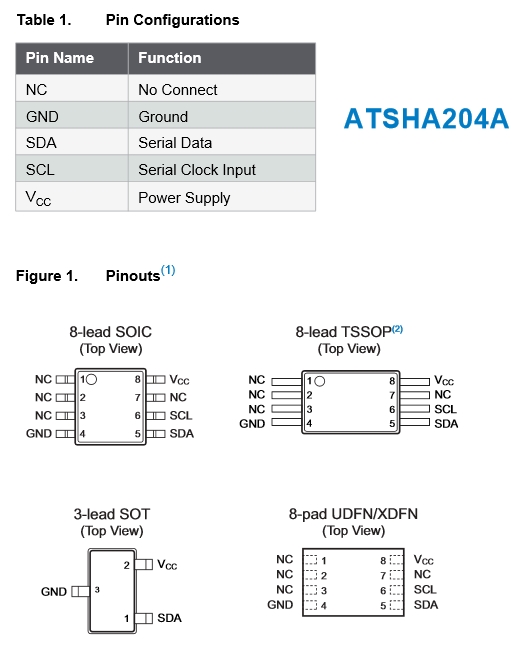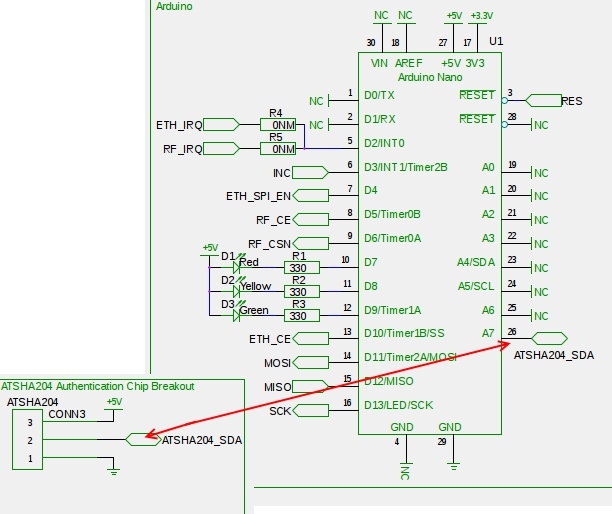[security] Introducing signing support to MySensors
-
hello, i'm making some mysensors board that I'll present you a bit later and I've add a place for the Atsha204 sot23-3.
I can't find it in Europe still and I would like to know if is it possible ton connect it on pin A6 instead of pin A3. I would like to keep the A0 to A5 for the user and use A6 for Atsha204 and A7 for Atcha204 floating point. Can anyone test it for me please?
Thank's verry much!
-
hello, i'm making some mysensors board that I'll present you a bit later and I've add a place for the Atsha204 sot23-3.
I can't find it in Europe still and I would like to know if is it possible ton connect it on pin A6 instead of pin A3. I would like to keep the A0 to A5 for the user and use A6 for Atsha204 and A7 for Atcha204 floating point. Can anyone test it for me please?
Thank's verry much!
-
Ok, So I've to connect it on A3 (default value in mysensor?) and let the A7 floating? The A6 is not used so? (other question : I can't use digitalWrite on A6 pin?)
Thank's verry much for the details on ATSHA204A instead of ATSHA204. The ATSHA204A is in SOT23-3 too? so the A7 is only use inside the Atmega library?
-
Ok, So I've to connect it on A3 (default value in mysensor?) and let the A7 floating? The A6 is not used so? (other question : I can't use digitalWrite on A6 pin?)
Thank's verry much for the details on ATSHA204A instead of ATSHA204. The ATSHA204A is in SOT23-3 too? so the A7 is only use inside the Atmega library?
@Tibus A6 and A7 are analog input pins. You can use them as such but not as digital I/O.
ATSHA204A is identical but more feature-rich compared to ATSHA204. One added feature is a SHA256 which is required for MySensors use. ATSHA204 is discontinued by Atmel. You can connect the ATSHA to any digital I/O pin you like but you will have to patch the config if you pick anything not called "A3". -
Ok, thank's! I've already change every A6 pin connection to A3. Can the user use A3 for analogic even if ATSHA204 is connected on it? or do I have to remove the A3 pin available for the user?
-
@Tibus You have to check the datasheet of ATSHA204A to see how it handles the datapin when not in use. I would recommend you have any analog cirquitry on dedicated pins though and keep one reserved for the ATSHA.
-
The "analog" pins can actually be used as digital IO pins.
-
@hek @tbowmo also found this the "hard" way. There are also some other forum discussions on the topic. It is basically how the AVR is designed.
-
I had this concerned from beginning. I will sound like a noon, but I am working on building a custom controller with loads of user configurable interface. For sake of my understanding is there any diagram or video or any resource regarding how to interface the ATSHA204A with arduino @Anticimex .
If there is something like that it will be of a great help. I am going to post a video soon of my work in progress app which controls the devices. I am also working on a scenario where someone can use the normal switches(existing ones) to operate the device and app will update accordingly. Still making way through the ACK part and the hops as I am using Ruby to do all the work -
I had this concerned from beginning. I will sound like a noon, but I am working on building a custom controller with loads of user configurable interface. For sake of my understanding is there any diagram or video or any resource regarding how to interface the ATSHA204A with arduino @Anticimex .
If there is something like that it will be of a great help. I am going to post a video soon of my work in progress app which controls the devices. I am also working on a scenario where someone can use the normal switches(existing ones) to operate the device and app will update accordingly. Still making way through the ACK part and the hops as I am using Ruby to do all the work -
@mainali
Does this help you? Sometimes a few pics say more than a 1000 words :)I made this pic from the Datasheet giving you the pinouts of the ATSHA204A in all known housings.

And the way how to connect is (shamelessly stolen from the GW design of @Anticimex :) )

-
@mainali
Does this help you? Sometimes a few pics say more than a 1000 words :)I made this pic from the Datasheet giving you the pinouts of the ATSHA204A in all known housings.

And the way how to connect is (shamelessly stolen from the GW design of @Anticimex :) )

-
@Anticimex
Thanks for that info, to me it is clear that depending on the used pin in the software one should connect the ATSHA204A corresponding with the software.
Picture does show you being correct how simple it really is to embed the ATSHA204A hardware in the total setup. -
@phil83
I fear you've already ordered the ATSHA204A ? I'm also in Germany so that would be easy.
If not - I'd take 10 pcs. They cost close to nothing -> nice :)@Anticimex
I don't agree with "This is an unlikely usecase because it is really no reason to sign sensor values. If you for some reason want to obfuscate sensor data, encryption is a better alternative."I think of Sensors used for Alarm-Systems. You need to trust the sensor reading because otherwise the attacker might jam the original Sensor and send his own Sensor data to let the alarm-system think the window is still closed (e.g.).
One more question: Are the Serials in the ATSHA in ascending order (i.e. when you have a reel of ICs is each S/N old S/N+1 ?) If this is the case, would it be possible to steal a keyfob to get a valid signing device, read the serial, use that S/N +1, sign the message and get still access to the garage door? I.e. do something one could call "S/N spoofing"? (I know that it is much easier to just break the garage door with a crowbar, but I'm intrested in this - at least hypotheticaly :))
Unfourtunately I don't have much time at the moment to try it out by myself, but I'm still really excited about your work and effort!
-
@phil83
I fear you've already ordered the ATSHA204A ? I'm also in Germany so that would be easy.
If not - I'd take 10 pcs. They cost close to nothing -> nice :)@Anticimex
I don't agree with "This is an unlikely usecase because it is really no reason to sign sensor values. If you for some reason want to obfuscate sensor data, encryption is a better alternative."I think of Sensors used for Alarm-Systems. You need to trust the sensor reading because otherwise the attacker might jam the original Sensor and send his own Sensor data to let the alarm-system think the window is still closed (e.g.).
One more question: Are the Serials in the ATSHA in ascending order (i.e. when you have a reel of ICs is each S/N old S/N+1 ?) If this is the case, would it be possible to steal a keyfob to get a valid signing device, read the serial, use that S/N +1, sign the message and get still access to the garage door? I.e. do something one could call "S/N spoofing"? (I know that it is much easier to just break the garage door with a crowbar, but I'm intrested in this - at least hypotheticaly :))
Unfourtunately I don't have much time at the moment to try it out by myself, but I'm still really excited about your work and effort!
@Dirk_H The signing solution can be applied to both sensors and gateways. If you feel the need to have the gateway require signed messages from nodes, there is nothing to prevent it. I have already thought of that scenario and implemented support for it.
Regarding jamming, no security system can prevent that.
Regarding the generation of serials, you have to contact Atmel about that. And you still need to obtain the preshared key in order to generate properly signed messages. Neither the key nor the serial is ever sent over the air in clear text.
